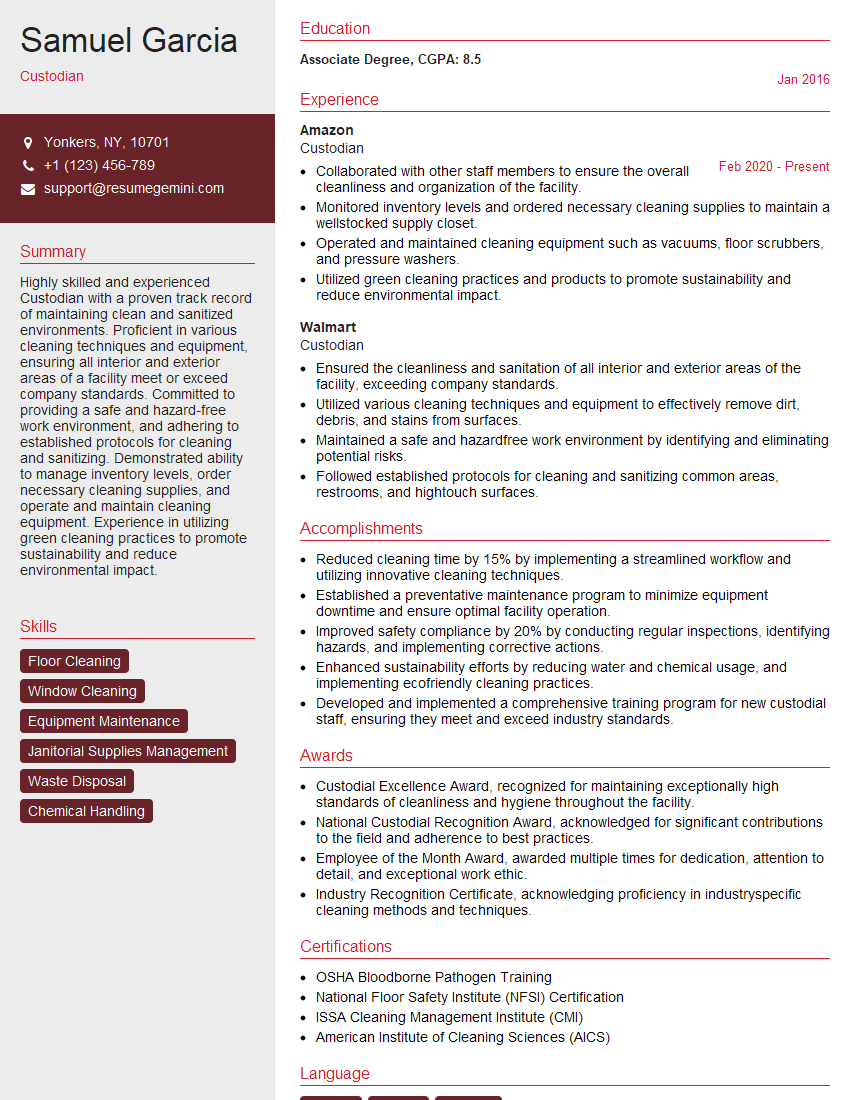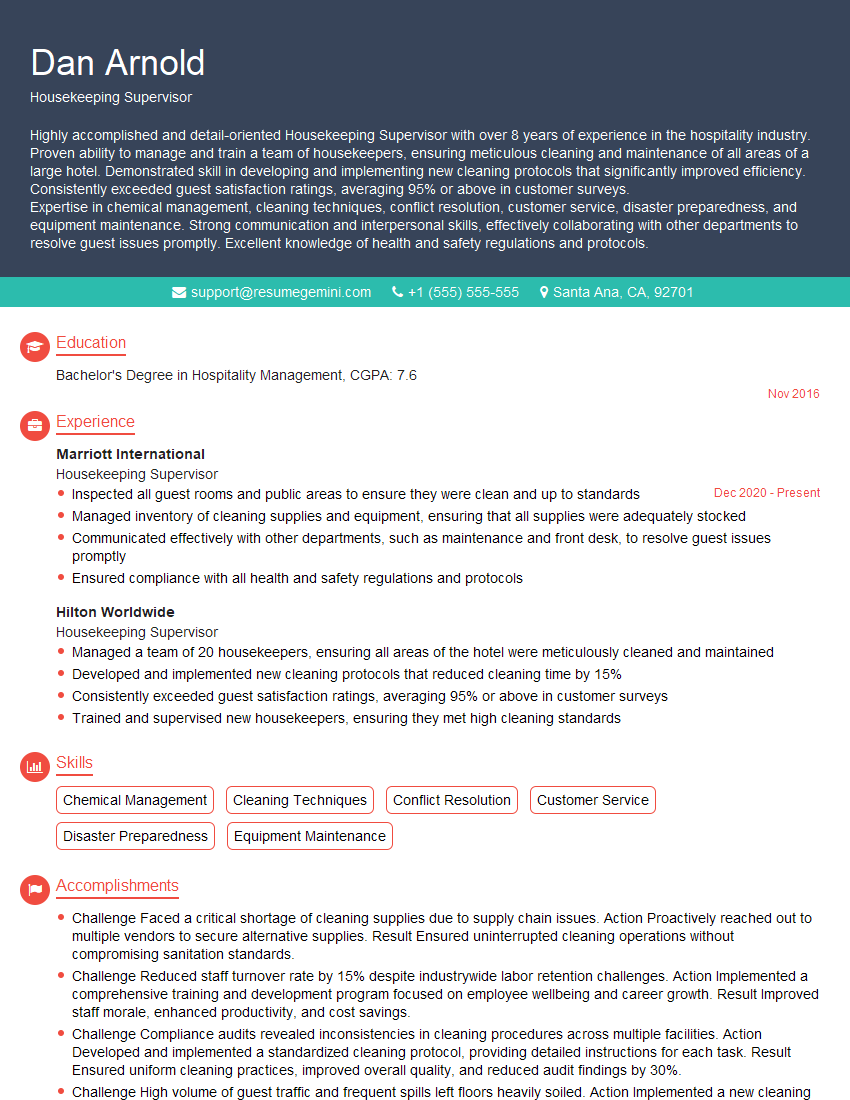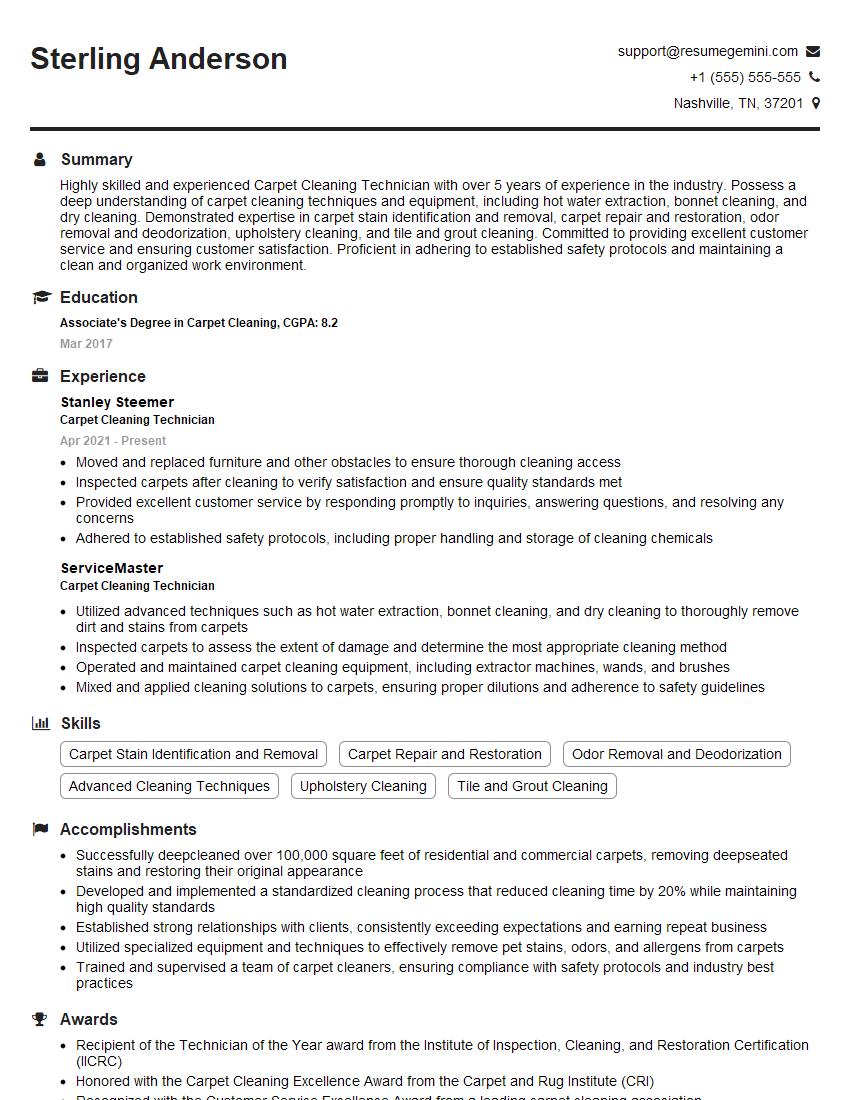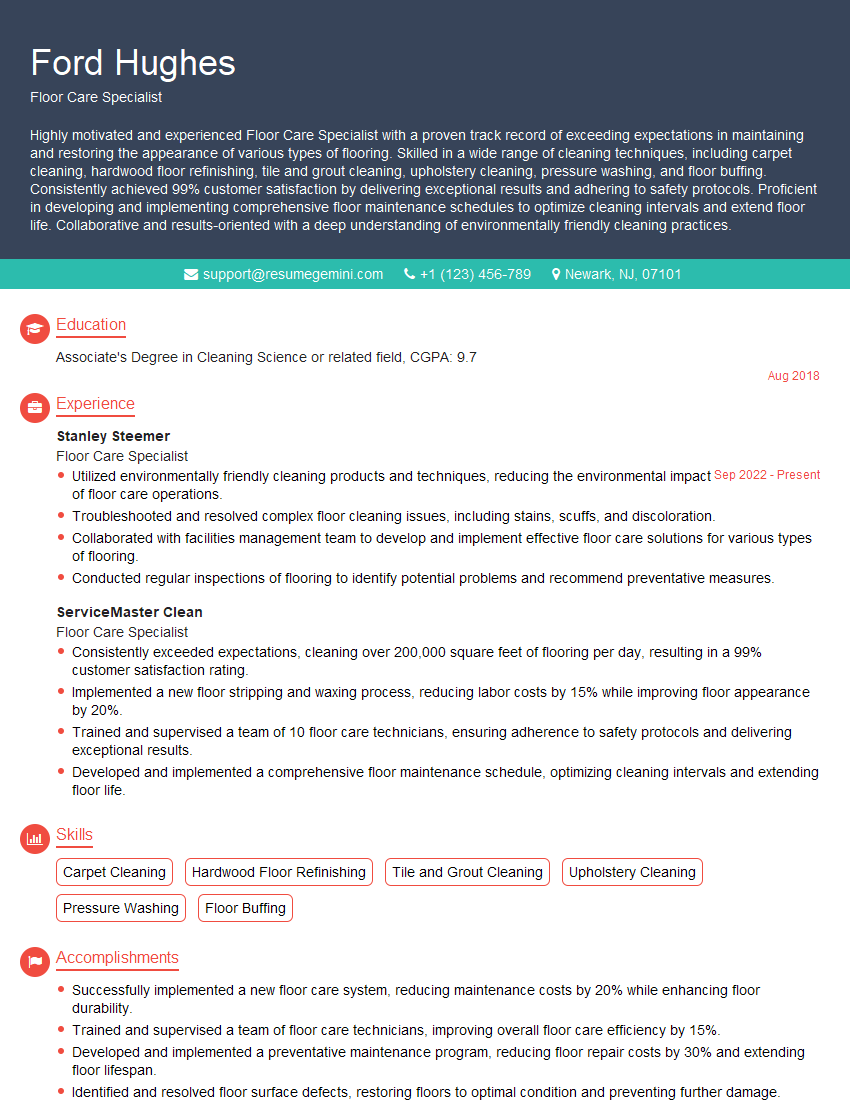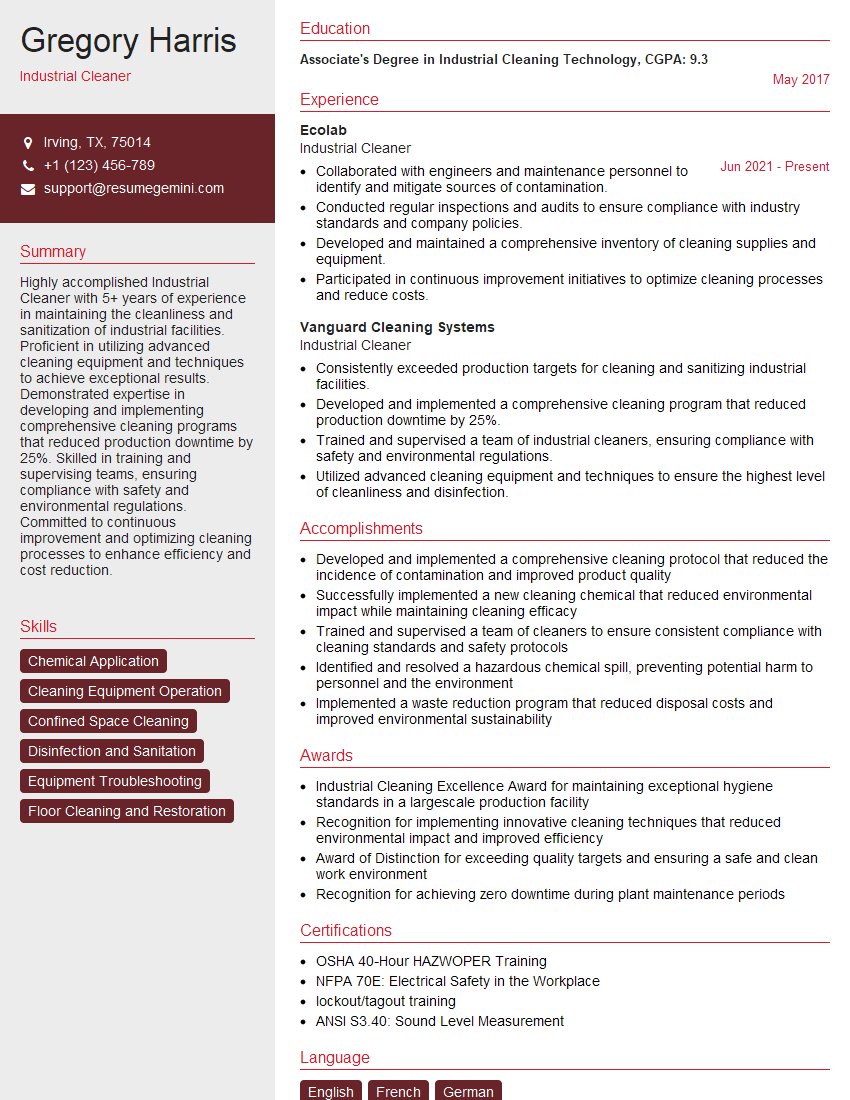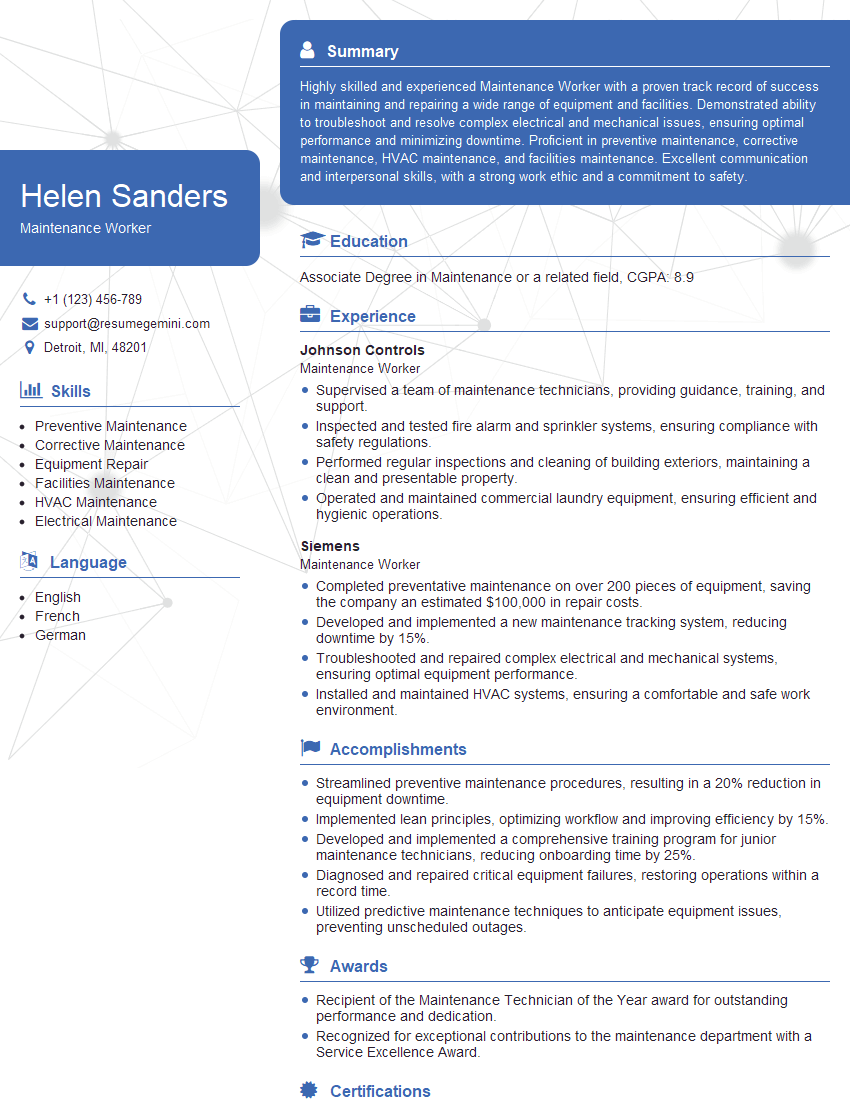Cracking a skill-specific interview, like one for Vacuuming and Brushing, requires understanding the nuances of the role. In this blog, we present the questions you’re most likely to encounter, along with insights into how to answer them effectively. Let’s ensure you’re ready to make a strong impression.
Questions Asked in Vacuuming and Brushing Interview
Q 1. What types of vacuum cleaners are you familiar with?
I’m familiar with a wide range of vacuum cleaners, categorized primarily by their cleaning mechanism and design. These include upright vacuums, canister vacuums, stick vacuums, robot vacuums, and handheld vacuums. Within each category, there are variations based on features like suction power, filtration systems (e.g., HEPA filters), and included attachments. For example, some uprights offer specialized carpet cleaning tools, while canister vacuums are often favored for their maneuverability and suitability for various floor types.
- Upright Vacuums: These are the classic, stand-up vacuums, ideal for larger cleaning tasks.
- Canister Vacuums: These separate the motor and dustbin from the cleaning head, providing more maneuverability.
- Stick Vacuums: Lightweight and cordless, perfect for quick cleanups and smaller spaces.
- Robot Vacuums: Automated cleaning solutions ideal for maintaining cleanliness between deeper cleans.
- Handheld Vacuums: Small and portable for quick spot cleaning of upholstery, stairs, etc.
Q 2. Explain the difference between a canister and upright vacuum.
The main difference lies in their design and how they operate. An upright vacuum has a single unit with the motor, dustbin, and cleaning head all integrated. This design makes them powerful for carpet cleaning but can be less maneuverable in tight spaces. Think of them as the workhorses, ideal for larger areas. A canister vacuum, on the other hand, separates the motor and dustbin (the canister) from the cleaning head, which is connected by a hose. This separation provides exceptional maneuverability, making them suitable for various floor types, including stairs and hard-to-reach areas. They often provide more suction power for their size. Imagine a canister vacuum as a more versatile tool, excellent for detailed cleaning.
Q 3. Describe the proper technique for vacuuming carpets.
Proper carpet vacuuming technique involves a methodical approach. First, always pre-treat any stubborn stains before vacuuming. Next, thoroughly clean any loose debris or pet hair from the carpet surface with a broom or dustpan. Start vacuuming at the furthest point of the room and work your way backward towards the exit. Overlapping each pass by about 50% ensures thorough cleaning. Maintain consistent speed to ensure even suction. Adjust the vacuum height setting according to the carpet pile height – low pile height requires low settings, whereas high-pile carpet needs a higher setting to avoid damaging fibers. For heavily soiled areas, make multiple passes in different directions to lift embedded dirt. Always empty the dustbin or bag when it becomes half full to ensure optimal suction. Regular maintenance of your vacuum, such as cleaning or replacing filters, is also essential for effective cleaning.
Q 4. How do you clean different types of flooring (e.g., hardwood, tile, carpet)?
Cleaning different flooring types requires different approaches and tools. For hardwood floors, use a vacuum cleaner with a hard floor attachment or a specialized brush to avoid scratching. Always ensure the floor is swept clean before vacuuming. Tile floors can be vacuumed similarly, but a damp mop afterwards is often recommended to remove any lingering dirt or grime. For carpets, the techniques mentioned earlier are crucial. Vacuuming regularly prevents dust mites from becoming entrenched. In case of difficult stains, spot cleaning may be necessary. Never use excessive water on carpets as they take a long time to dry, promoting mold and mildew growth.
Q 5. What are the different types of brushes used in cleaning and their applications?
Various brushes are designed for specific cleaning tasks. Soft bristle brushes are ideal for delicate surfaces like hardwood floors, preventing scratches. Hard bristle brushes are better suited for scrubbing stubborn dirt from rougher surfaces like grout. Upholstery brushes are designed with softer bristles to prevent damage to fabric. Specialized brushes, such as those with crevice tools, are meant for narrow spaces. Some vacuum cleaners also include motorized brushes, offering increased cleaning power, especially for carpets. Finally, specialized dusting brushes are ideal for cleaning delicate items, like electronics or picture frames.
Q 6. How do you determine the appropriate brush for a specific cleaning task?
Choosing the right brush depends entirely on the surface you are cleaning and the type of dirt you’re dealing with. For delicate surfaces like hardwood floors, a soft-bristled brush is essential. Stubborn dirt on grout lines demands a stiff-bristled brush. For upholstery, opt for an upholstery brush to avoid snagging or damaging the fabric. If you’re cleaning a narrow crevice, a crevice tool is indispensable. Always refer to the manufacturer’s instructions for your vacuum cleaner and the cleaning recommendations for your flooring type.
Q 7. Describe your experience with various cleaning solutions.
My experience with cleaning solutions ranges from basic water-based solutions for everyday cleaning to specialized products for removing specific stains or disinfecting. For general cleaning of hard surfaces, diluted all-purpose cleaners are often sufficient. However, for tougher stains or disinfecting, more specialized products are necessary. Always test any cleaning solution on an inconspicuous area first to ensure it doesn’t damage the surface. I’m well-versed in using environmentally friendly cleaning solutions, which are becoming increasingly popular. When working with any cleaning solution, always follow the manufacturer’s instructions and take appropriate safety precautions, such as wearing gloves.
Q 8. How do you handle stubborn stains or dirt?
Tackling stubborn stains and dirt requires a multi-pronged approach. It’s not a one-size-fits-all solution; the best method depends heavily on the type of stain and the surface material.
For example, a dried-on sauce stain on a carpeted area might require pre-treatment with a stain remover specifically designed for fabrics. I would apply the remover, gently work it into the stain using a soft brush, and allow it to dwell for the recommended time before vacuuming. For tougher stains, I might repeat this process or even consider using a steam cleaner for deeper penetration. On harder surfaces like tile, a solution of warm water and a mild detergent, scrubbed gently with a non-abrasive brush or sponge, usually does the trick. Stubborn grease stains might require a degreaser, always ensuring compatibility with the surface material to avoid damage.
I always test any cleaning solution on an inconspicuous area first to check for colorfastness or potential damage. Documenting the cleaning process and any solutions used is crucial, especially for large-scale jobs or in a commercial setting. This helps maintain consistency and track efficacy. Remember, patience is key; aggressive scrubbing can often worsen the problem.
Q 9. What safety precautions do you follow when using cleaning equipment?
Safety is paramount. When using any cleaning equipment, I always prioritize personal protective equipment (PPE). This includes wearing safety glasses or goggles to protect my eyes from debris, dust, and cleaning solutions. Gloves are essential to prevent skin irritation and protect against harsh chemicals. If working with powerful vacuums or in a confined space, a respirator might be necessary to avoid inhaling dust and allergens.
Before operating any equipment, I thoroughly inspect it for any damage, loose parts, or malfunctioning components. I always follow the manufacturer’s instructions and safety guidelines. This includes properly grounding electrical equipment and using extension cords only when necessary and in a safe manner. I never operate equipment near water or other sources of moisture and ensure adequate ventilation when using cleaning solutions. Awareness of surroundings is key to prevent tripping hazards or collisions with furniture.
Q 10. How do you maintain cleaning equipment?
Regular maintenance is crucial for the longevity and efficiency of cleaning equipment. For vacuums, this includes regularly emptying the dustbin or bag, replacing filters as recommended by the manufacturer, and checking the hoses and attachments for any blockages or damage. I also ensure the brushes and rollers are clean and free of hair or debris. For industrial vacuums, I might need to perform more involved tasks like checking belts, lubricating moving parts (following manufacturer’s guidelines), and inspecting the motor for any unusual sounds or vibrations.
Cleaning solutions and brushes also require maintenance. Solutions should be stored correctly, preventing spills and degradation. Brushes should be cleaned after each use to remove any accumulated dirt or debris, prolonging their lifespan. This prevents cross-contamination and ensures optimal performance.
Q 11. What is your experience with high-powered industrial vacuum cleaners?
I have extensive experience with high-powered industrial vacuum cleaners, including models with HEPA filtration systems for removing fine dust and allergens. I’m familiar with various types, including wet/dry vacuums, those designed for specific materials (like concrete dust), and those with specialized attachments for different cleaning tasks. My experience encompasses their proper operation, safety protocols, and the maintenance required for such powerful machines. I understand the importance of regular filter changes, especially when dealing with hazardous materials. For example, when working with asbestos, specific safety protocols and specialized vacuums with HEPA filtration are crucial to prevent harmful exposure.
I have used them in a variety of settings, ranging from large-scale construction sites to industrial facilities, always prioritizing safety and operational efficiency. Understanding the power settings and appropriate attachments is crucial for optimal performance and to prevent damage to surfaces.
Q 12. How do you ensure efficient cleaning processes?
Efficient cleaning processes hinge on several factors. Firstly, a systematic approach is crucial. I typically start with a comprehensive survey of the area, identifying high-traffic areas, stubborn stains, and any special considerations (fragile items, delicate materials). Then, I strategically plan the cleaning route, optimizing movement to avoid redundant steps.
Secondly, selecting the right tools and equipment is crucial. Using appropriate brushes, cleaning solutions, and vacuum attachments for different surfaces ensures optimal results and minimizes cleaning time. For instance, a soft-bristled brush for delicate furniture and a stiff-bristled brush for tougher surfaces. Thirdly, effective time management is paramount, as I will discuss later. Finally, regularly inspecting the work ensures thorough cleaning and addresses any missed areas.
Q 13. How do you manage your time effectively during cleaning tasks?
Effective time management during cleaning tasks is about efficient planning and execution. I prioritize tasks based on their urgency and impact, tackling high-traffic areas and visible messes first to create a noticeable improvement quickly. I break down large tasks into smaller, manageable chunks, which makes them less daunting and allows for better tracking of progress. I also avoid distractions and maintain a steady pace to maximize productivity. Using checklists helps ensure thoroughness and prevents overlooking details. For example, when cleaning an office, I might start with emptying trash cans and dusting surfaces before vacuuming and mopping.
Ultimately, efficiency comes from experience; I learn to anticipate the time required for various tasks, which helps with accurate time estimation and scheduling for future projects.
Q 14. Describe your experience with cleaning different types of surfaces.
My experience spans a wide range of surfaces, from delicate hardwood floors and marble countertops to robust carpets and industrial concrete. I understand the specific cleaning requirements for each material, adapting techniques and equipment accordingly. For hardwood floors, I use specialized cleaning solutions and microfiber mops to avoid scratching. Carpets require different vacuum settings and attachments to remove embedded dirt effectively. Delicate fabrics necessitate gentle cleaning methods and appropriate cleaning solutions to avoid damage or color fading. For industrial settings, I’m adept at cleaning large areas of concrete, using powerful vacuums and appropriate cleaning agents to remove dust, grime, and spills safely and efficiently.
In each situation, my approach is customized to the specific material, considering its properties and potential sensitivities. I always prioritize minimizing damage and preserving the integrity of the surface while achieving a thorough clean.
Q 15. How do you prioritize cleaning tasks in a large area?
Prioritizing cleaning in a large area requires a systematic approach. Think of it like conquering a large battlefield – you wouldn’t charge in randomly! I typically use a zone cleaning method. First, I divide the area into manageable sections, perhaps rooms or distinct zones. Then, I prioritize based on traffic flow and the level of soiling. High-traffic areas like entrances and hallways get tackled first, followed by less frequented spaces. This ensures that the most visible and potentially germ-ridden areas are cleaned thoroughly. For instance, in an office building, I’d start with the reception area and common walkways before moving to individual offices. Using a checklist ensures nothing is missed, and regularly updating the checklist based on observed patterns in soiling helps to refine the process further.
Career Expert Tips:
- Ace those interviews! Prepare effectively by reviewing the Top 50 Most Common Interview Questions on ResumeGemini.
- Navigate your job search with confidence! Explore a wide range of Career Tips on ResumeGemini. Learn about common challenges and recommendations to overcome them.
- Craft the perfect resume! Master the Art of Resume Writing with ResumeGemini’s guide. Showcase your unique qualifications and achievements effectively.
- Don’t miss out on holiday savings! Build your dream resume with ResumeGemini’s ATS optimized templates.
Q 16. How do you deal with unexpected cleaning challenges?
Unexpected cleaning challenges are inevitable, and adaptability is key. Imagine you’re vacuuming and suddenly encounter a large spill. My response is always methodical. First, I assess the situation – what’s spilled? Is it hazardous? Then, I take appropriate safety measures, like wearing gloves and using the correct cleaning agent. For example, a coffee spill requires a different approach than a chemical spill. After the immediate hazard is dealt with, I adjust my cleaning plan accordingly, focusing on the affected area before continuing with the original schedule. Documentation is vital here; I record unexpected issues and solutions to improve future preparedness.
Q 17. How do you dispose of cleaning waste properly?
Proper waste disposal is crucial for hygiene and environmental responsibility. I follow all local regulations and company policies religiously. This includes using designated bins for different types of waste – separating recyclable materials, hazardous waste (like cleaning chemicals), and general trash. For instance, used vacuum cleaner bags are always disposed of in sealed plastic bags to prevent dust and debris from escaping. I meticulously label all hazardous waste containers and ensure they’re properly secured before disposal by an authorized waste removal service. This minimizes environmental impact and prevents potential health hazards.
Q 18. How do you ensure that cleaning meets hygiene standards?
Maintaining hygiene standards requires a multi-faceted approach. It starts with using appropriate cleaning agents, and following the manufacturers’ instructions precisely, paying close attention to contact times for effective disinfection. I regularly check and maintain my equipment – ensuring vacuums have clean filters and brushes, and that all tools are properly sanitized between uses. My personal hygiene is also paramount; I always wear appropriate protective gear like gloves and aprons, and practice proper hand hygiene. Regular training on updated hygiene protocols keeps my practices aligned with best practices and ensures I consistently meet the highest standards.
Q 19. What are the different types of cleaning chemicals and their uses?
The cleaning chemical landscape is diverse. We have all-purpose cleaners for general dirt and grime, disinfectants to kill germs and bacteria (like bleach solutions, but used with caution and according to instructions), degreasers for removing stubborn grease and oil, and specialized cleaners for particular surfaces like glass or wood. Each has its unique application. For example, I wouldn’t use a strong degreaser on a delicate wood surface, opting instead for a wood-specific cleaner. Understanding the chemical properties of each product is crucial to ensure both effectiveness and safety, and to prevent damage to surfaces.
Q 20. How do you handle spills and accidents?
Handling spills and accidents is about swift, safe action. First, I assess the spill – the type of substance, its quantity, and potential hazards. I then contain the spill to prevent it from spreading further. This might involve using absorbent materials like paper towels or specialized spill kits. Next, I carefully clean the area using the appropriate cleaning agent, always following safety precautions. Finally, I document the incident, noting the time, location, type of spill, and the actions taken. This helps to prevent future occurrences and ensure a safe work environment.
Q 21. How do you assess the cleanliness of a space?
Assessing cleanliness isn’t just about visual inspection. It involves a multi-sensory approach. I visually inspect surfaces for dirt, stains, and debris. I also use my sense of touch to check for residual stickiness or grime. In addition, I might use specialized tools like UV lights to detect unseen contaminants. A systematic approach, such as following a detailed checklist, ensures that all areas are checked thoroughly, leading to a complete and accurate assessment. A post-cleaning inspection is critical to verify that the cleaning process has effectively removed soiling and achieved the desired level of cleanliness.
Q 22. Describe your experience with different types of floor polishing machines.
My experience with floor polishing machines spans a wide range of models, from basic single-speed buffers to high-speed orbital polishers and even specialized machines for intricate floor types like marble or hardwood. I’m proficient in operating both rotary and orbital machines, understanding the crucial differences in their applications and the potential risks associated with each. For instance, rotary machines, while powerful for heavy-duty cleaning, require a higher level of skill to avoid damaging the floor surface due to their aggressive spinning action. Orbital machines, on the other hand, are gentler and safer for delicate floors but may require longer cleaning times for the same level of shine.
I’ve worked with machines from various manufacturers, each with its unique features and maintenance requirements. This includes understanding the proper application of polishing compounds and sealants to achieve optimal results depending on the floor material. I always prioritize proper safety protocols, including using appropriate personal protective equipment (PPE) like eye protection and earplugs, and ensuring the machine is in proper working order before commencement. For example, I recently used a high-speed orbital polisher to restore the shine to a large marble floor in a commercial building, employing different polishing pads and compounds to achieve a flawless finish.
Q 23. How do you handle complaints about cleaning services?
Handling complaints about cleaning services involves a calm and professional approach. My first step is to actively listen to the client’s concerns, acknowledging their frustration and validating their feelings. I avoid becoming defensive and instead focus on understanding the specific issue. This often involves asking clarifying questions to pinpoint the exact problem, such as the location, the nature of the issue, and any relevant context. I then assess the situation, determining whether it’s a matter of oversight, a problem with the cleaning process, or perhaps an unrealistic expectation on the client’s part.
Based on my assessment, I’ll offer a solution. This might involve immediate rectifying the problem, such as returning to re-clean an area, or scheduling a follow-up visit to address the concern properly. If the complaint is due to miscommunication regarding the scope of work, I explain the cleaning process in detail, ensuring transparency. If it’s a genuine issue with the service, I promptly take responsibility and take corrective action, aiming for a satisfactory resolution. I always document the complaint and the steps taken to resolve it, keeping a record for future reference and improving my service.
Q 24. What are your skills in using specialized cleaning tools (e.g., steam cleaners)?
I am highly proficient in using a variety of specialized cleaning tools, including steam cleaners. My expertise includes understanding the different types of steam cleaners available—from portable handheld units to larger industrial models—and their appropriate applications. For instance, I know that handheld steamers are ideal for grout cleaning and upholstery sanitizing, while industrial models are better suited for large-scale floor cleaning in commercial settings.
My skills encompass safe and efficient operation, including understanding water pressure and temperature settings, as well as proper maintenance, such as regular descaling and cleaning of the machine. I’m also familiar with the various cleaning solutions compatible with steam cleaners, selecting the most appropriate one based on the surface type and the type of soil to be removed. I always prioritize safety, making sure to use caution when handling hot steam and ensuring the area is properly ventilated. For example, I recently used a steam cleaner to effectively remove stubborn grease stains from a kitchen floor, restoring its cleanliness and shine.
Q 25. How would you train a new employee on proper vacuuming and brushing techniques?
Training a new employee on proper vacuuming and brushing techniques begins with a thorough overview of safety procedures, including the correct handling of equipment and the importance of wearing appropriate PPE. I then demonstrate the proper techniques for various floor types, emphasizing the importance of adapting techniques based on the surface material (carpet, hardwood, tile, etc.).
The training includes hands-on practice, with me supervising and providing feedback. This involves demonstrating proper vacuuming techniques, such as using overlapping strokes to ensure complete coverage, understanding the correct height adjustment for different carpet piles, and emptying the dustbin regularly. Brushing techniques are also covered, including the correct type of brush for different surfaces, the pressure to apply, and the importance of proper stroke direction. I’d assess their performance regularly, providing constructive criticism and focusing on improving their skills. Finally, I would emphasize the importance of maintaining equipment cleanliness and regular maintenance to ensure optimal performance and longevity.
Q 26. What is your experience with scheduling and coordinating cleaning tasks?
I have extensive experience with scheduling and coordinating cleaning tasks, utilizing various methods to efficiently manage my workload. This includes creating detailed cleaning schedules that prioritize tasks based on their urgency and the client’s specific needs. I use both digital calendars and physical checklists to keep track of appointments, ensuring I stay on track and meet deadlines.
My experience also includes prioritizing tasks based on urgency and client preferences. I can manage multiple tasks simultaneously, prioritizing efficiency and effectiveness. For example, I might schedule cleaning tasks for multiple clients in close proximity to minimize travel time and maximize efficiency. I can also adapt my schedule quickly to meet unexpected requests, ensuring flexibility and responsiveness. I use communication tools to stay in touch with clients and update them on my progress, proactively informing them of any potential delays or scheduling changes.
Q 27. How do you work safely around other people during cleaning?
Working safely around other people during cleaning requires constant vigilance and awareness. I always prioritize clear communication, letting others know my location and what I’m doing. This prevents accidents, such as bumping into people or causing tripping hazards. I use caution when using cleaning solutions, properly labeling containers and ensuring adequate ventilation to minimize the risk of exposure to chemicals.
I also maintain a clean and organized work area, minimizing clutter and potential hazards. I’m mindful of not blocking walkways or doorways, and I consistently keep my equipment safely stored when not in use. In high-traffic areas, I adjust my work schedule to minimize disruption, performing less disruptive cleaning tasks during off-peak hours. I’m always aware of my surroundings and prioritize the safety of others above all else. If there are children or pets in the area, I take extra care to secure cleaning supplies out of their reach.
Q 28. What are some innovative methods or technology you are familiar with in cleaning?
I’m familiar with several innovative methods and technologies in cleaning, including the use of robotic vacuum cleaners, which offer automated cleaning solutions and significantly reduce manual labor. These robots often incorporate advanced features such as mapping capabilities and smart scheduling options, improving efficiency and customization. I’m also acquainted with eco-friendly cleaning products that minimize environmental impact while maintaining cleaning efficacy.
Furthermore, I’m aware of advancements in cleaning solution chemistry, with products designed to be more effective with less harsh chemicals. I also stay updated on new types of microfiber cleaning cloths, which offer superior cleaning capabilities and durability compared to traditional materials. The use of these technologies and materials significantly improves cleaning results while promoting sustainability and employee safety. For example, I recently integrated a robotic vacuum into my cleaning routine for a large office space, freeing up time for more specialized tasks.
Key Topics to Learn for Vacuuming and Brushing Interview
- Understanding Vacuum Systems: Different types of vacuum cleaners (upright, canister, handheld), their functionalities, and appropriate applications for various surfaces and cleaning tasks. Explore the mechanics of suction and filtration.
- Brush Selection and Application: Identifying the correct brush attachments for different materials (carpet, upholstery, hardwood floors). Understanding the principles of bristle stiffness, material composition, and their impact on cleaning effectiveness.
- Cleaning Techniques and Procedures: Mastering efficient vacuuming and brushing techniques to minimize time and maximize cleaning results. Learn best practices for different surfaces and how to handle delicate materials.
- Maintenance and Troubleshooting: Familiarize yourself with routine maintenance procedures for vacuum cleaners and brushes (e.g., emptying dustbins, replacing filters, cleaning brushes). Understand common problems and basic troubleshooting steps.
- Health and Safety: Learn about safety protocols related to operating vacuum cleaners and handling cleaning materials. Understand ergonomic principles for minimizing strain during cleaning tasks.
- Cleaning Solutions and Chemicals: Understanding the appropriate use of cleaning solutions and chemicals with various vacuum and brush systems. Know the safety precautions and environmental considerations for their application.
- Specialized Applications: Explore niche applications such as cleaning sensitive electronics or specialized surfaces (e.g., antique furniture). This demonstrates advanced knowledge and adaptability.
Next Steps
Mastering vacuuming and brushing techniques is crucial for career advancement in many cleaning and maintenance industries. A strong understanding of these skills demonstrates professionalism, efficiency, and attention to detail – highly valued attributes in any workplace. To significantly boost your job prospects, create an ATS-friendly resume that highlights your expertise. ResumeGemini is a trusted resource that can help you build a professional and impactful resume, ensuring your skills and experience shine. Examples of resumes tailored to the Vacuuming and Brushing field are available to guide you. Take the next step towards your dream job today!
Explore more articles
Users Rating of Our Blogs
Share Your Experience
We value your feedback! Please rate our content and share your thoughts (optional).
What Readers Say About Our Blog
Hello,
We found issues with your domain’s email setup that may be sending your messages to spam or blocking them completely. InboxShield Mini shows you how to fix it in minutes — no tech skills required.
Scan your domain now for details: https://inboxshield-mini.com/
— Adam @ InboxShield Mini
Reply STOP to unsubscribe
Hi, are you owner of interviewgemini.com? What if I told you I could help you find extra time in your schedule, reconnect with leads you didn’t even realize you missed, and bring in more “I want to work with you” conversations, without increasing your ad spend or hiring a full-time employee?
All with a flexible, budget-friendly service that could easily pay for itself. Sounds good?
Would it be nice to jump on a quick 10-minute call so I can show you exactly how we make this work?
Best,
Hapei
Marketing Director
Hey, I know you’re the owner of interviewgemini.com. I’ll be quick.
Fundraising for your business is tough and time-consuming. We make it easier by guaranteeing two private investor meetings each month, for six months. No demos, no pitch events – just direct introductions to active investors matched to your startup.
If youR17;re raising, this could help you build real momentum. Want me to send more info?
Hi, I represent an SEO company that specialises in getting you AI citations and higher rankings on Google. I’d like to offer you a 100% free SEO audit for your website. Would you be interested?
Hi, I represent an SEO company that specialises in getting you AI citations and higher rankings on Google. I’d like to offer you a 100% free SEO audit for your website. Would you be interested?
good
